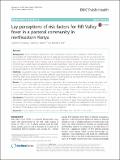Files in this item
Lay perceptions of risk factors for Rift Valley fever in a pastoral community in northeastern Kenya
Item metadata
| dc.contributor.author | Mburu, Caroline | |
| dc.contributor.author | Bukachi, Salome A. | |
| dc.contributor.author | Bett, Bernard K. | |
| dc.date.accessioned | 2022-07-11T09:30:20Z | |
| dc.date.available | 2022-07-11T09:30:20Z | |
| dc.date.issued | 2016-01-13 | |
| dc.identifier | 280400972 | |
| dc.identifier | c548c267-7b4f-4e30-b1c1-5b9bf6a0c534 | |
| dc.identifier | 84954534925 | |
| dc.identifier.citation | Mburu , C , Bukachi , S A & Bett , B K 2016 , ' Lay perceptions of risk factors for Rift Valley fever in a pastoral community in northeastern Kenya ' , BMC Public Health , vol. 16 , 32 . https://doi.org/10.1186/s12889-016-2707-8 | en |
| dc.identifier.issn | 1471-2458 | |
| dc.identifier.other | ORCID: /0000-0002-8460-9213/work/115631007 | |
| dc.identifier.uri | https://hdl.handle.net/10023/25646 | |
| dc.description | Authors thank the community in Ijara for participating in the study and Millicent Liani for assisting with data collection and providing access to relevant literature. We acknowledge the Food Safety and Zoonoses Research Program at the International Livestock and Research Institute in Nairobi (funded by the CGIAR research program on Agriculture for Nutrition and Health (A4NH) led by the International Food Policy Research Institute. Part of this work was supported by the project ‘Dynamic Drivers of Disease in Africa: Ecosystems, livestock/wildlife, health and wellbeing: REF:NE/J001422/1” funded by the Ecosystem Services for Poverty Alleviation Programme (ESPA). The ESPA program is funded by the Department for International Development (DFID), the Economic and Social Research Council (ESRC) and the Natural Environment Research Council (NERC). | en |
| dc.description.abstract | Background: Human behavioral factors have been found to be central in the transmission of Rift Valley fever. Consumption of contaminated meat and milk in particular have been identified as one of the key risk factors for the transmission of Rift Valley fever in humans. In pastoral communities, livestock is the main source of livelihood from which many benefits such as food as well as economic and cultural services are derived. Zoonotic diseases therefore have a great impact on pastoral communities livelihoods. However, lay perceptions regarding the transmission of these diseases including Rift Valley fever hampers their effective control. This study investigated the lay perceptions of risks for Rift Valley fever transmission in a pastoral community in northeastern Kenya. Methods: A qualitative study was carried out in Ijara district, Kenya which was one of the hotspots of Rift Valley during the 2006/2007 outbreak. Data were collected using focus group discussions and narratives guided by checklists. Eight focus group discussions consisting of 83 participants and six narratives were conducted. Data was transcribed, coded and analysed according to Emergent themes. Results: The participants reported that they had experienced Rift Valley fever in their livestock especially sheep and in humans both in 1997/1998 and 2006/2007. However, they believed that infections in humans occurred as a result of mosquito bites and had little to do with their consumption of meat, milk and blood from infected livestock. The participants in this study indicated that they had heard of the risks of acquiring the disease through consumption of livestock products but their experiences did not tally with the information they had received hence to them, Rift Valley fever was not transmissible through their dietary practices. Conclusions: Though the communities in this region were aware of Rift Valley fever, they did not have elaborate information regarding the disease transmission dynamics to humans. To avoid misconception about transmission of the disease, intervention strategies, require to be accompanied by comprehensive explanations of the dynamics of its transmission. It is necessary to develop appropriate interventions that take into consideration, lay perceptions of risk factors for the disease and communities’ livelihood strategies. | |
| dc.format.extent | 10 | |
| dc.format.extent | 932057 | |
| dc.language.iso | eng | |
| dc.relation.ispartof | BMC Public Health | en |
| dc.subject | Lay perceptions | en |
| dc.subject | Food consumption practices | en |
| dc.subject | Rift Valley fever | en |
| dc.subject | Risk factors | en |
| dc.subject | Pastoralism | en |
| dc.subject | GN Anthropology | en |
| dc.subject | RA0421 Public health. Hygiene. Preventive Medicine | en |
| dc.subject | SDG 3 - Good Health and Well-being | en |
| dc.subject.lcc | GN | en |
| dc.subject.lcc | RA0421 | en |
| dc.title | Lay perceptions of risk factors for Rift Valley fever in a pastoral community in northeastern Kenya | en |
| dc.type | Journal article | en |
| dc.contributor.institution | University of St Andrews. Social Anthropology | en |
| dc.identifier.doi | https://doi.org/10.1186/s12889-016-2707-8 | |
| dc.description.status | Peer reviewed | en |
This item appears in the following Collection(s)
Items in the St Andrews Research Repository are protected by copyright, with all rights reserved, unless otherwise indicated.

